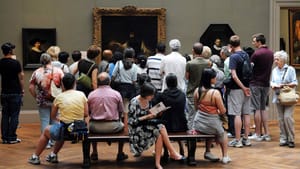Stay in the Loop
BSR publishes on a weekly schedule, with an email newsletter every Wednesday and Thursday morning. There’s no paywall, and subscribing is always free.
Troubling trends in the arts
Survey of Public Participation in the Arts

The National Endowment for the Arts conducts a Survey of Public Participation in the Arts in conjunction with the census every decade. The most recent survey paints a troubling portrait of the arts in America.
While a majority of Americans (71 percent) listen to music, see a movie, or engage with the arts in one of the many electronic or digital platforms available today, a declining minority attend live performances or leave their house to see art – except for movies. The survey does not differentiate between artistic movies and the latest mega-budget comic book movie, so movie viewership is on the rise (59 percent).
In 1992, 41 percent of adult Americans attended at least one live cultural performance or visited an art museum or gallery. By 2012, the number had decreased to 33.3 percent. Much of that decline was due to a precipitous downturn in those who attended classical music concerts (down by 24 percent) or attended the theater (down 9 percent for musical plays and 12 percent for non-musical plays).
Why the decline?
Surveys like this can give you the facts, but not the answers. However, when you look at several different kinds of surveys about arts and art funding over the last 20 years, reasons can be seen through a glass darkly.
And the survey says
Since 1992, total government arts funding in American has declined by 31 percent, according to Grantmakers in the Arts.
Classical music and local theater have long been dependent on public or private funding to keep them going. Whether you think this is a good or bad idea, the fact is that most theaters and orchestras would collapse if they had to depend solely on box office to support themselves.
The Department of Education made a detailed study, released last year, that concluded that there has been a steady decline in teaching the arts in our schools:
[F]or theater and dance in elementary schools, the percentages of schools making these art forms available went from 20 percent 10 years ago to only 4 and 3 percent, respectively, in the 2009-10 school year. In addition, at more than 40 percent of secondary schools, coursework in arts was not required for graduation in the 2009-10 school year.
The National Arts Journalism Program found a decline in reporting on the arts in media in a 1999 study; somewhat dated, but do you think arts reporting (BSR, of course, excluded) has gotten better since 1999?
The NEA reports that the income of artists is far below the income of other professionals — and this study has a serious flaw by counting all of an artist’s income instead of only that related to his or her work as an artist. There are very few artists I know who make their living solely from their art (present company, I am happy to report, excluded).
So, let’s sum up. The state of the arts in America reflects:
-
Declining public participation for all art except TV and movies
-
Declining public funding
-
Declining teaching of the arts in our schools
-
Declining reporting on arts in our media
-
Declining wages for artists
Conclusion: Whether or not we admit it, we have made a decision, as a nation, to turn away from the arts. They have become less and less important to us. Even in the best of times, art has been the purview of the few, but now the few have turned into the very few.
What next?
As we continue to cut funding, courses, and arts-related jobs, we may see a time when even our major arts institutions struggle to find audiences. And the longer we head down this path, the less chance there is that art will have an impact on our culture — an impact that may help us reverse the course we are on.
When is the last time that a work of art has had an impact on our culture — on the way we think and live? When is the last time a work of art has prompted widespread discussion or been seen as a game-changing development? Tony Kushner’s Angels in America (1991)? Robbins/Bernstein/Sondheim’s West Side Story (1957)? Jackson Pollock’s Full Fathom Five (1947)? I am not saying that these are the last great works of art in their respective fields, only that they may be the last to have had widespread cultural impact.
We don’t need a survey to understand that the less we support, teach, and attend performances of art, the less art will mean to us. The less it means to us, the less we will support, teach and — you get the picture. It’s not pretty.
Sign up for our newsletter
All of the week's new articles, all in one place. Sign up for the free weekly BSR newsletters, and don't miss a conversation.

 Armen Pandola
Armen Pandola